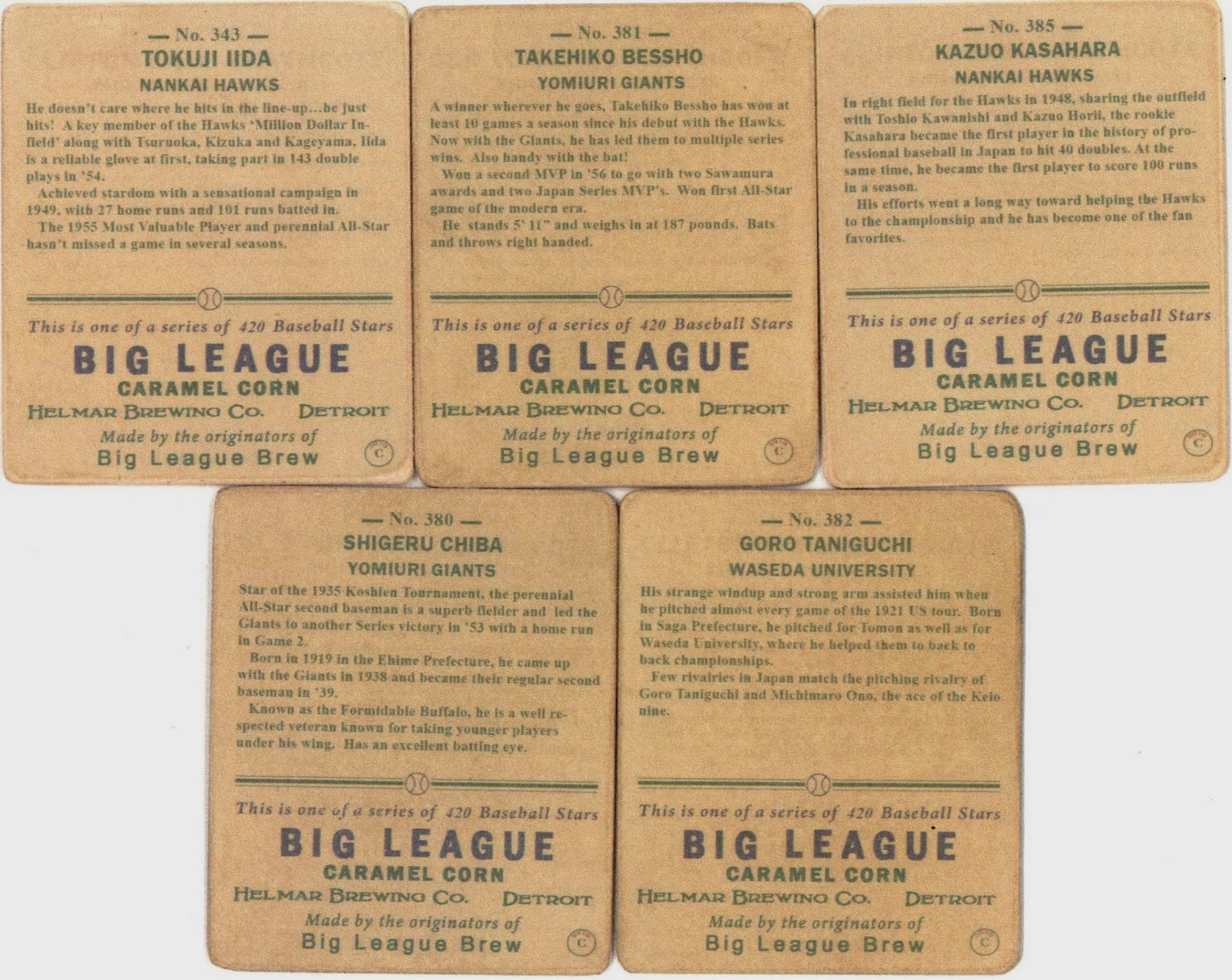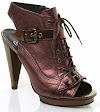Helmar and Hirayama
The photo above is well known to collectors of Japanese baseball cards, not only because it is from a photo-bromide card that features three Hall of Famers (Noboru Aota, Tetsuharu Kawakami, and Shigeru Chiba), but because Helmar Brewing used the image on one card in a set that features many stars of Japan's golden age of baseball. The fourth man in the image, Kikuji Hirayama, was mis-identified on the Helmar card as Noguchi. Recently, Helmar contacted me to assist in properly identifying the player as well as assist with a new set of cards. More on that in a bit, but first, a look at Kikuji (or Kikuni) Hirayama.
It is understandable that Hirayama could be overlooked - though he played in the Golden era of Japanese Baseball, and spent the majority of his career on the most popular team, he has never been recognized by the Hall of Fame, and has otherwise languished in the shadow of his superstar teammates.
******
The 1950 Japan Series was the first of it's kind in Japan - pitting two brand new teams, stocked with old talent, in a championship dual that would set the bar for all to follow. The Robins and the Orions battled six rounds, with the decision coming in the 11th inning of that sixth contest, as
 That 1950 season, in which Japanese professional baseball first split into a Central and a Pacific league, presented challenges to many players who had been in the league a long time. As the leagues evened themselves out, many players found new homes as teams saw room to move up younger, and cheaper, talent. Kikuji Hirayama (above) was one of those players, in a new environment and pitted against his former teammates as a member of the expansion Taiyo Whales. Along with Takeshi Miyazaki and Kamekazu Yasui, Hirayama provided the speed and on base presence to assist sluggers Kiyoshi Osawa and Isamu Fujii in scoring the runs that brought the Whales a respectable middle-of-the-division finish. However, it could never measure up to his glory with the Giants.
That 1950 season, in which Japanese professional baseball first split into a Central and a Pacific league, presented challenges to many players who had been in the league a long time. As the leagues evened themselves out, many players found new homes as teams saw room to move up younger, and cheaper, talent. Kikuji Hirayama (above) was one of those players, in a new environment and pitted against his former teammates as a member of the expansion Taiyo Whales. Along with Takeshi Miyazaki and Kamekazu Yasui, Hirayama provided the speed and on base presence to assist sluggers Kiyoshi Osawa and Isamu Fujii in scoring the runs that brought the Whales a respectable middle-of-the-division finish. However, it could never measure up to his glory with the Giants.Kikuji Hirayama (above) was a shortstop and third baseman in high school but went to the outfield during his stint in the industrial leagues. Born in Shimonoseki, Yamaguchi prefecture, he was an infielder for the Shogyo High School team.
He played for the Hiroshima Tetsudo Kanrikyoku, an industrial league team on which he moved from playing primarily the third base side of the infield to the outfield.
His first year with the Giants was during the second campaign of professional baseball, during the spring and fall seasons of 1937. Only 19, he did not see much action in his first two seasons, but had some wonderful experience, winning it all alongside Eiji Sawamura and Victor Starffin under Hall of Fame manager Sadayoshi Fujimoto in the first real "full" season of professional baseball in the Fall of '37, and playing alongside Haruyasu Nakajima as he became the first player in Japan to win a triple crown in the Spring of 1938.
He had his breakout season in '39, placing third in the batting race and holding his own along with his future Hall of Fame teammates Tetsuharu Kawakami, Shigeru Chiba, Nakajima, Toshio Shiraishi, Shigeru Mizuhara, and Osamu Mihara among others. Though known today as the Yomiuri Giants, the team was then known as the Tokyo Kyojin, and they won the pennant every season Hirayama (below) played with them before the war. He left after the '41 season, eventually participating in the Burma campaign, not returning until the '47 season. He picked up right where he had left off as a speedster and defensive asset.
Though Noboru Aota had played with the Giants during the first two years of his career, his time in the outfield did not overlap with Hirayama, who had left just before Aota's first tenure. Instead, they were reunited for the 1948 season, and the two, together with Hiroshi Hagiwara, formed an outfield that, for two seasons, was the best in baseball. It was here, in 1948, that he earned his nickname as "The Fenceside Magician" for a stellar play in left field, at one time snagging a home run just over the fence during an all star game. It was said that he owed some of his defensive prowess to dance lessons. However, at the beginning of the 1950 season, Hirayama left the Giants, possibly for personal reasons, and sought out a new team. The expansion Whales provided a good fit (below), close to his home town and a place where he could be a leader.
After his fine season in '50, Hirayama hurt himself and missed almost the entire 1951 season. He came back a lesser player, and could only manage 77 games for the Whales that year. However, he was rejoined by his former outfield partner when, before the 1952 season, Noboru Aota was traded to the Whales. Hirayama could still not muster a full season, but performed admirably alongside Aota. He retired after the season and worked for the Whales front office, as they flip-flopped between the nickname "Whales" and "Robins", seeing their investment in Aota pay off as he twice led the league in home runs. Hirayama eventually became scouting director, and, after recruiting former Giants teammate Osamu Mihara as manager for the 1960 season, saw his Whales win the Japan Series for the first time, beating out the Daimai Orions in four games. He continued on in the front office, but, unfortunately, died just months before his team, by then known as the Yokohama Bay Stars, won a second championship in 1998.
Self Advertisement
As mentioned above, in addition to clarification on the Hirayama issue, Helmar asked that I provide some 1933-Goudey-style copy for the new set of cards that have just recently been released. Below are some examples, with bios written by me, for your viewing pleasure. Enjoy!
















0 Yorumlar